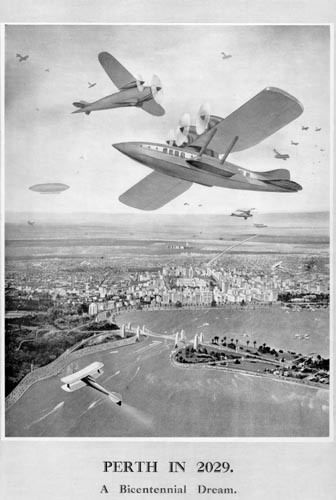 | ||
In 1929, Western Australia celebrated the centenary of the founding of Perth and the establishment of the Swan River Colony, the first permanent European settlement in WA. A variety of events were run in Perth, regional areas throughout the state, and even across Australia such as the Western Australian Centenary Air Race.
Contents
Preparations
In 1926, the 25th anniversary of federation passed without much recognition, due in part to the sense of isolation that help to form Western Australia's identity. There was limited acknowledgement from the other states of the unique circumstances of Western Australia's situation, due to what historian Geoffrey Blainey described as "the tyranny of distance". It was this isolation that helped focus the community on celebrating its centenary; later, it would also be the catalyst for a growing secessionist movement.
In 1927, the premier, Phillip Collier, asked Hal Colebatch to write a history of the state, and in 1929 A Story of a hundred years : Western Australia, 1829-1929 was published.
A celebration committee began preparations in 1928, and in 1929 produced a number of publications including calendars of events. As 1929 approached, most towns formed their own committees and organised events, these ranged from special race meetings to regional shows, formal dinners, dances and sporting events. Additionally some towns and community organisations also renamed existing local features like parks and buildings, while others set aside an area for a monument which was then unveiled in the presents of dignitaries including the Governor, Premier and descendants of the early settlers.
Other events held in Perth in 1929
In April 1929 there was an Australian Fire Brigade Demonstration held in Perth.
In June 1929 there was the Australian national general Methodist conference.
In July 1929 there were interstate football games held in Perth.
Centenary celebrations
Many locations in Western Australia had buildings or locations that became known as Centenary memorials; for example the Claremont Showgrounds has a Centenary Pavilion that still stands, and Northam had a Centenary Hill.
Avenues of trees were planted in Kings Park in commemoration of the event as well as honouring people involved in the celebrations.
The Perth Branch of the Royal Mint produced a commemorative medal. Most of the 85,000 medals struck were bronze, and the majority were given to Western Australian school children. 900 silver medals were also made, as were 3 gold medals.
12 August 1929
The Governor Sir William Campion presided at the placement of a plaque in the wall of the Perth Town Hall on Barrack Street that recorded the centenary celebrations in August.
Centenary Celebration Period
The Centenary Celebration Period was designated as 28 September 1929 – 12 October 1929.
Despite a range of events involving various national bodies in the year, the specific main event was the 1929 Centenary Parade, which was held on Wednesday 2 October (which had been made a public holiday) and known as the Historic and Industrial Procession, passing through Perth.
2 October 1929
Wednesday 2 October 1929 was a public holiday in Perth.
The main Centenary procession (1929 Centenary Parade) involved considerable preparation of floats representing commercial and regional attributes of the state. It passed through the streets of Perth.
The Centenary Ball and celebrations at the Perth Oval were also held.
The afternoon at Perth Oval on the same day was the site of a Naval and Military Tournament.
Subsequent events
In September, 1929, a choir of 1,000 voices sang at a Children's Thanksgiving Mass in Victoria Square, and also in a Centenary concert in His Majesty's Theatre.
On 24 November 1929, the Kings Park War Memorial Cenotaph was unveiled by the Governor William Campion to commemorate the fallen of World War I.
Fremantle
One of the events organised was a re-enactment of the 1829 arrival of settlers at Fremantle, attended by Campion.
Prisoner remissions
In October, the Premier, Phillip Collier announced that prisoner sentences of more than one month would be reduced at the rate of two days for each month of sentence remaining, after allowing for good conduct. Prisoners serving sentences during His Majesty's pleasure were excluded from the remissions.
Proximity to Depression
Western Australian historian Geoffrey Bolton ties in the events and the subsequent difficult times due to the economic depression in his book A Fine Country to Starve in (1972). While more recently Annette Davis looked at the popular entertainment values of the era.
Legacy
A significant amount of the organisation of the celebrations was attributed to the librarian James Sykes Battye, whose efforts in organising committees were noted in the celebration year.
Historical Society plaques
The Royal Western Australian Historical Society commissioned plaques that were ceremonially placed upon locations of significance to Western Australia. Locations included:
